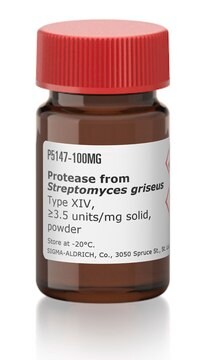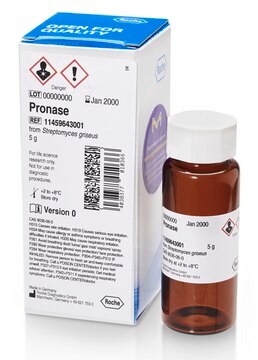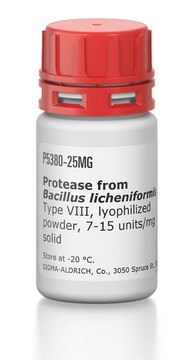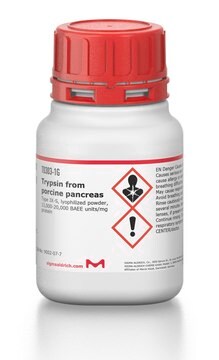53702
Pronase® Protease, Streptomyces griseus
Sinônimo(s):
Pronase® powder
Faça loginpara ver os preços organizacionais e de contrato
About This Item
Produtos recomendados
descrição
RTECS - UK9595000
Nível de qualidade
Formulário
lyophilized
atividade específica
≥45,000 proteolytic units/g dry wt
fabricante/nome comercial
Calbiochem®
condição de armazenamento
OK to freeze
desiccated (hygroscopic)
solubilidade
water: 10 mg/mL
Condições de expedição
ambient
temperatura de armazenamento
2-8°C
Descrição geral
A non-specific protease liquefies mucins and digests proteins to free amino acids. Can be used to isolate living chondrocytes. Most active at neutral pH, but it is stable over a wide pH and temperature range. Has an optimal pH of 7.5. Note: 1 KU = 1000 units.
Note: 1 KU = 1000 units.
Advertência
Toxicity: Harmful (C)
Definição da unidade
One unit is defined as the amount of enzyme that will liberate a digestion product equivalent to 25 µg of tyrosine per min at 40°C, pH 7.5.
forma física
Lyophilized from a solution containing calcium acetate as a stabilizer.
Reconstituição
Following reconstitution, store in the refrigerator (4°C). Stock solutions are stable for 24 h at 4°C.
Outras notas
Narahashi, Y., et al. 1968. J. Biochem. 64, 427.
Informações legais
CALBIOCHEM is a registered trademark of Merck KGaA, Darmstadt, Germany
PRONASE is a registered trademark of Merck KGaA, Darmstadt, Germany
Palavra indicadora
Danger
Frases de perigo
Declarações de precaução
Classificações de perigo
Eye Irrit. 2 - Resp. Sens. 1 - Skin Irrit. 2 - STOT SE 3
Órgãos-alvo
Respiratory system
Código de classe de armazenamento
11 - Combustible Solids
Classe de risco de água (WGK)
WGK 2
Certificados de análise (COA)
Busque Certificados de análise (COA) digitando o Número do Lote do produto. Os números de lote e remessa podem ser encontrados no rótulo de um produto após a palavra “Lot” ou “Batch”.
Já possui este produto?
Encontre a documentação dos produtos que você adquiriu recentemente na biblioteca de documentos.
Os clientes também visualizaram
W N Ross et al.
The Journal of neuroscience : the official journal of the Society for Neuroscience, 4(3), 659-672 (1984-03-01)
Optical techniques using voltage-sensitive dyes were used to record electrical events simultaneously from many positions on certain neurons of the barnacle supraesophageal ganglion. By signal-averaging, recordings with good signal-to-noise ratios and time resolution were obtained from fine dendritic processes as
T E Davis et al.
Infection and immunity, 15(3), 978-987 (1977-03-01)
Enzymes capable of hydrolyzing cell walls of Blastomyces dermatitidis and chemotypes I and II of Histoplasma capsulatum were prepared in the laboratory or obtained from commercial sources. They included chitinases, beta-1,3-glucanases, beta-1,6-glucanase, and Pronase. Monosaccharides and disaccharides of glucose released
Saurabh Dahiya et al.
Human molecular genetics, 20(22), 4345-4359 (2011-08-19)
Matrix metalloproteinases (MMPs) are a group of extracellular proteases involved in tissue remodeling in several physiological and pathophysiological conditions. While increased expression of MMPs (especially MMP-9) has been observed in skeletal muscle in numerous conditions, their physiological significance remains less-well
M Tsacopoulos et al.
The Journal of neuroscience : the official journal of the Society for Neuroscience, 17(7), 2383-2390 (1997-04-01)
Glial cells transform glucose to a fuel substrate taken up and used by neurons. In the honeybee retina, photoreceptor neurons consume both alanine supplied by glial cells and exogenous proline. Ammonium (NH4+) and glutamate, produced and released in a stimulus-dependent
S Kästner et al.
The journal of histochemistry and cytochemistry : official journal of the Histochemistry Society, 48(8), 1079-1096 (2000-07-18)
Satellite cells are the myogenic precursors in postnatal muscle and are situated beneath the myofiber basement membrane. We previously showed that fibroblast growth factor 2 (FGF2, basic FGF) stimulates a greater number of satellite cells to enter the cell cycle
Nossa equipe de cientistas tem experiência em todas as áreas de pesquisa, incluindo Life Sciences, ciência de materiais, síntese química, cromatografia, química analítica e muitas outras.
Entre em contato com a assistência técnica














